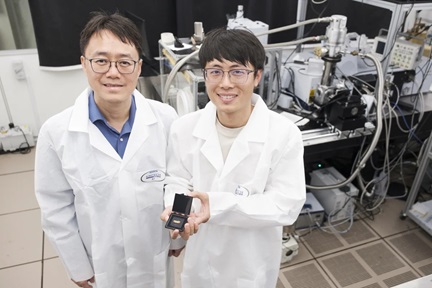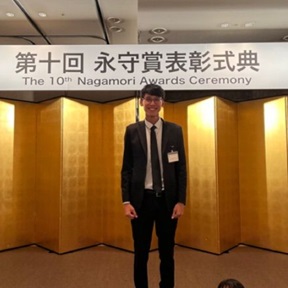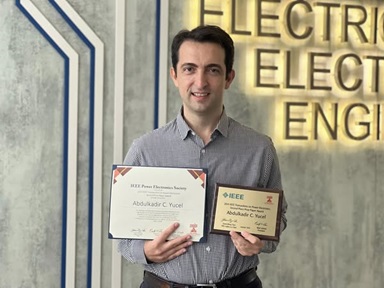Noise cancelling device by NTU EEE scientists halves noise pollution through open windows
Researchers from the School of Electrical and Electronic Engineering (NTU EEE) at Nanyang Technological University, Singapore have developed a device that can reduce noise pollution entering buildings through open windows.
Designed to be mounted onto window grilles, the device could reduce up to 50 per cent of noise coming from nearby environments such as busy roads, train tracks or from construction activities.
The device uses ‘active noise control’ technology – found in many high-end headphones that cancels external noise – and adapted to work in a large open area.
The benefits are two-fold: windows can be left open for fresh air without disturbance from external noise pollution, and reducing the need for air-conditioning to keep the interiors of buildings and homes cool.
NTU EEE Professor Gan Woon Seng, Director for NTU EEE’s Centre for Infocomm Technology (INFINITUS), who led the research said, “Compared to noise cancellation headphones, what we have achieved is far more technically challenging as we needed to control the noise in a large open area, instead of just around the ear." Prof Gan’s team comprises researchers Mr Lam Bhan, Mr Shi Dongyuan and Mr Belyi Valiatsin.
This noise cancellation technology is an example of research innovations that NTU is encouraging under its Smart Campus initiative, which aims to improve quality of life for society through the development of new sustainable and technological solutions and by trialling them on its campus first.
Using sound to remove noise
Currently at the prototype stage, the device uses 8 watts of power, similar to a small portable Bluetooth speaker. Several units are placed together to form a grid-like array on a window grille to reduce external noise.
The device uses a special sound emitting mechanism which works like a speaker and is hooked up to a processing unit. Equipped with a microphone, it can detect noise even before it reaches the window and computes the attributes of the incoming noise in real-time.
It quickly emits a countering sound or “anti-noise” that has the same waveform characteristics of the invading noise but with one difference: it is inverted or “flipped”.
When both outside noise and anti-noise converge, they cancel each other out, resulting in a softer ambient sound entering living spaces.
“Our innovation not only computes the right amount and type of “anti-noise” to emit, but also does it faster than the detected noise can reach inside the building,” explained Prof Gan, who teaches at NTU’s School of Electrical & Electronic Engineering.
The NTU EEE research team conducted the tests using a soundproof chamber at the university’s labs that houses a mock room with windows and doors, resembling a typical room in a home. Various recorded sounds from construction sites, jet engines and trains were used as noise sources during the tests.
They are now developing the technology further by improving its noise cancellation efficiency, making them smaller, and more cost-effective to produce.
NTU EEE Prof Gan said, “We are currently finding ways to improve the technology further so that it can be used not only at window grilles with large openings, but also provide a cost-effective solution that can be easily installed and replaced. Ultimately, we aim to integrate this technology into window grilles that can help mitigate urban noise pollution conveniently.”
Professor Yoon Soon Fatt, Chair of NTU EEE, added, “The School of Electrical and Electronic Engineering, being a research intensive school, we strive to ensure that our research is translational and sustainable. This latest work is part of NTU EEE’s research efforts to support the Singapore government’s Smart Nation initiative in translational research. NTU EEE’s research in this domain has shown real translational results benefiting Singaporeans and public agencies.”
The researchers are also working with government agencies in Singapore to further improve the technology to make it viable for commercial and residential applications.
The project was jointly developed with the University of Southampton in the United Kingdom, and Tottori University in Japan.
It is supported by Singapore’s Ministry of National Development and the National Research Foundation in the Prime Minister’s Office, under the ‘Land and Liveability National Innovation Challenge’ (L2 NIC) Research Programme.
The initiative seeks to leverage R&D to develop innovative technological solutions to increase Singapore's land capacity for its long-term development needs and provide tech-based options for future generations.
NTU EEE Professor Gan Woon Seng (centre) with NTU EEE reseachers Mr Lam Bhan (left), Mr Shi Dongyuan and Mr Belyi Valiatsin (not in the photo).
Media contact:
Nur Amin Shah (Mr)
Assistant Manager (Media Relations)
Corporate Communications Office
Nanyang Technological University, Singapore
Email: [email protected]
- Coverage of NTU’s open window noise cancellation technology initiated by CCO. See the news release and video made by CCO.
About Nanyang Technological University
A research-intensive public university, Nanyang Technological University, Singapore (NTU Singapore) has 33,500 undergraduate and postgraduate students in the colleges of Engineering, Business, Science, Humanities, Arts, & Social Sciences, and its Interdisciplinary Graduate School. It also has a medical school, the Lee Kong Chian School of Medicine, set up jointly with Imperial College London.
NTU is also home to world-class autonomous institutes – the National Institute of Education, S Rajaratnam School of International Studies, Earth Observatory of Singapore, and Singapore Centre for Environmental Life Sciences Engineering – and various leading research centres such as the Nanyang Environment & Water Research Institute (NEWRI) and Energy Research Institute @ NTU (ERI@N).
Ranked 11th in the world, NTU has also been placed the world’s top young university for the last four years. The University’s main campus is frequently listed among the Top 15 most beautiful university campuses in the world and has 57 Green Mark awards (equivalent to LEED-certified), of which 54 are Green Mark Platinum. NTU also has a campus in Novena, Singapore’s medical district.
For more information, visit www.ntu.edu.sg
Less noise, even with windows wide open
The Straits Times, 1 May 2018, page B3 (with blurb on page A2) and online (photos provided by CCO)
Device to reduce noise from outside
The Straits Times, 1 May 2018, page B3 (with photos provided by CCO)
NTU device can reduce noise pollution by up to half, targeted for use in 2 to 3 years
The Straits Times online, 30 April 2018
NTU develops a device that can reduce noise pollution when installed on window grilles
Lianhe Zaobao, 1 May 2018, page 8
NTU develops noise cancelling device which can halve the noise pollution even without closing windows
Shin Min Daily News, 30 April 2018, page 10 (with photo provided by CCO)
NTU develops noise cancelling device that when mounted on the window grilles, can halve the noise pollution through open windows
Lianhe Wanbao, 30 Apr, page 4 (with photo provided by CCO)
Device that can cut noise pollution by half developed by NTU researchers
Channel NewsAsia online, 30 April 2018 (includes video interview with Prof Gan Woon Seng)
Locally developed noise cancelling device halves noise pollution
Channel 8 online, 30 April 2018 (includes video interview with NTU researchers)
NTU researchers develop device that halves noise pollution
Berita Mediacorp, 30 April 2018
End to problem of loud neighbours? Scientists create noise-cancelling windows that can reduce sounds by up to 50%, even when left open
The Daily Mail online (UK) (with photos, video and infographics provided by CCO)
Scientists create noise-cancelling windows that can reduce sound by up to 50 per cent
Express Digest (US) (with infographics and photos provided by CCO)
NTU researchers develop technology to reduce noise pollution through open windows
OpenGov, 30 April 2018 (with infographics and photos provided by CCO)
Window that silences your noisy neighbours
The Daily Mail (UK), 1 May 2018, page 25
Noise-cancelling windows could be the next boom industry
The Times (UK), 1 May 2018
Sound idea! The window that silences noisy neighbours...
Irish Daily Mail (Ireland), 1 May 2018, page 18
Window that can cut down on noise nuisance...even when it's left open!
The Scottish Daily Mail (Scotland), 1 May 2018, page 5
Shut out loud neighbours for good! Scientists reveal window which reduces noise pollution by 50%
Yahoo UK, 1 May 2018
Noise cancelling device halves noise pollution through open windows
TechXplore (US), 1 May 2018 (with infographics provided by CCO)
Prototype Device Aims to Reduce Noise Pollution via Open Windows
World Industrial Reporter (Philippines), 1 May 2018(with video and photo provided by CCO)
Urban dwellers will like the sound of these noise-cancelling windows
NBC News online (US), 2 May 2018 (with infographics and video provided by CCO)
Noise-cancelling windows soften the sounds of the city
New Atlas (US), 2 May 2018 (with photo, video and infographics provided by CCO)
Scientists create noise-cancelling device for buildings
The Fifth Estate (AU), 2 May 2018 (with photo provided by CCO)
Listen up: Device designed to hush exterior noise
ProudGreenBuilding (US), 2 May 2018 (with video provided by CCO)
Noise-Cancelling Windows Are Perfect for People Already Rich Enough To Find Quiet in the City
SciencePage (US), 2 May 2018
Tired of city noise? Noise-cancelling windows might be the answer
Techaeris (US), 2 May 2018 (with photo and video provided by CCO)
Urban dwellers will like the sound of these noise-cancelling windows
Digital Trends, 1 May 2018 (with infographics and video provided by CCO)
New noise-cancelling windows can reduce outdoor sounds even when open
GorgeousFM (US), 2 May 2018 (with photo provided by CCO)
New noise-cancelling windows can reduce outdoor sounds even when open
Sky News (UK), 2 May 2018
Researchers Create Noise-Cancelling Windows
Econo Times (US), 2 May 2018







